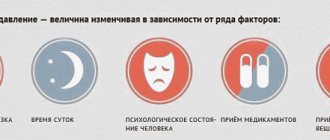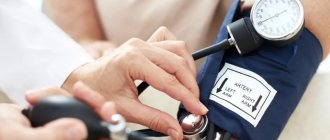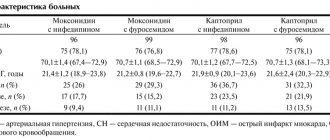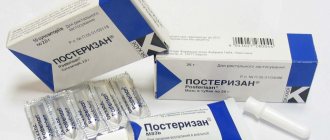Prevention of hypertension
Every adult should monitor their blood pressure. In case of high blood pressure, you should consult a doctor.
Less than one fifth of hypertensive patients control their condition.
People with high blood pressure who also have high blood sugar, high blood cholesterol or kidney problems are at increased risk of heart attack and stroke. Therefore, it is important to regularly check your blood sugar levels, blood cholesterol levels and urine protein levels.
There are a number of specific steps everyone can take to minimize the risk of developing high blood pressure and its adverse effects:
Mental balance
Mental well-being and a positive emotional state are essential conditions for maintaining health. What is especially important for patients with hypertension or predisposed to its development, because the disease is directly related to an inadequate response to stress.
It is necessary to learn how to manage stress in healthy ways such as meditation, various types of psychotherapy and positive social contacts.
Physical activity
The second component of the prevention of hypertension is sufficient physical activity, without which we all suffer to varying degrees from manifestations of physical inactivity.
For a city dweller, it would be optimal to walk for at least 1 hour every day in a forested area.
Patients with an already manifested disease should engage in physical therapy.
It is necessary to adhere to a regime of rational alternation of work and rest. Overwork of any type, both mental and physical, should not be allowed. Healthy physiological sleep is of great importance, during which the body rests from all stress. Patients at the initial stage of hypertension should sleep at least 8-9 hours a day.
Healthy eating
In the prevention of hypertension, proper nutrition or diet in clinically pronounced forms of the disease is of great importance.
Carbohydrates
Here you should give preference to vegetables and fruits, as this will allow you to get a sufficient amount of fiber, vitamins and minerals.
Squirrels
When choosing proteins, you should avoid or limit meat products in favor of dairy and plant-based ones.
Fats
Total fat intake should be reduced. Try to replace animal fats with vegetable fats, and among animal fats there should be more fish fats.
A diet with limited salt can be a cure for patients with hypertension. No more than 5 g (slightly less than one teaspoon) is allowed per day, which makes control over blood pressure levels much easier.
Maintain a normal weight
Reducing excess weight or treating obesity is the main factor that can lead to satisfactory control of blood pressure and even, in some cases, abandon drug correction of the latter.
An effective means for normalizing weight is diet therapy and various types of physical activity.
Rejection of bad habits
If a person is prone to drinking alcohol in large doses or smoking, then the risk of hypertension increases many times over.
Alcohol intake promotes spasm of peripheral vessels and increased blood pressure due to increased vascular resistance.
After smoking, cholesterol levels increase, which is due to the release of large amounts of adrenaline and norepinephrine from the adrenal glands. There is even such a medical term - nicotine hypertension.
Physical methods for preventing the development and exacerbations of hypertension
Hydrotherapy
Hydrotherapy (hydrotherapy) is a powerful means of recovery, prevention and treatment of hypertension. Water can affect the body as a temperature, mechanical or chemical irritant, and the choice depends on the need for one or another factor of influence.
The temperature factor is the most important in choosing a hydrotherapy technique. Skin capillaries expand and contract in response to exposure to water of varying temperatures. In this case, either an increase in blood flow or a decrease in it occurs. Cold water also slows and increases heart rate and increases blood pressure. Hot water lowers blood pressure, speeds up the heart rate and weakens heart contractions
Most often, to prevent exacerbations of hypertension, water at an indifferent temperature is used, which is indicated for excessive nervous excitability, irritability, cardiac dysfunction, and insomnia.
Hydrotherapy procedures are contraindicated for stage III hypertension.
Before using water treatments as a treatment, you should consult your doctor.
For hypertension stages I-II, rain, dust and circular showers are used using indifferent or warm water with moderate pressure from water jets.
Baths can be general and local; in case of hypertension they are used for therapeutic and preventive purposes. Medicinal baths for hypertension are limited to the use of pine extract.
Physical therapy (physical therapy) is used at all stages of hypertension to prevent hypertensive crises and complications of the disease. It includes any available types of physical exercise - dosed walking, morning exercises, health path, swimming.
“Exercise can replace many medications, but no medicine in the world can replace exercise.”
The best way of prevention is morning exercises or exercises, which allows you to prepare the body for a working day, stimulates the processes of nervous regulation of blood circulation and the reactivity of the vascular system as a whole.
If the disease has already developed, then you should add a daily complex of therapeutic exercises to the morning exercises.
Drug therapy
The selection of medications for the treatment and prevention of exacerbations of hypertension should be carried out only by a doctor.
Drug therapy becomes necessary already at the second stage of the disease, when blood pressure reaches significant levels with regular measurements.
The main principle is the individual selection of antihypertensive drugs for each patient.
Cardiovascular diseases cause approximately 17 million deaths per year, almost a third of total deaths. Of these, complications of hypertension cause 9.4 million deaths in the world annually. Hypertension accounts for at least 45% of deaths due to heart disease and 51% of deaths due to stroke.
If hypertension is detected early, it is possible to minimize the risk of heart attacks, stroke, heart failure and kidney failure.
The likelihood of developing high blood pressure and its adverse effects can be minimized by taking the following measures:
- maintaining a healthy lifestyle with an emphasis on proper nutrition;
- reducing salt intake to less than 5 g per day;
- consumption of five servings of fruits and vegetables per day;
- reducing intake of saturated fat and total fat;
- cessation of alcohol abuse;
- to give up smoking;
- regular physical activity. Physical activity should be given at least 30 minutes a day, five times a week;
- maintaining normal body weight;
- stress control.
Arterial hypertension (AH) is the most common chronic disease of the cardiovascular system among the adult population. More than 40 million adult Russians suffer from hypertension.
Lifestyle with hypertension: psychological relief
One of the basic rules of life with hypertension is to protect your psyche from unbearable stress. Psychological relief for hypertensive patients is constantly necessary. Firstly, you need to reduce, as much as possible, the likelihood of conflict situations, both at work and at home. Don’t worry about or without reason, learn to be tolerant of the shortcomings of loved ones and colleagues, and also reduce your emotional response to unusual situations in public transport, on the street, when communicating with neighbors, etc. An instant reaction to a stimulus provokes a surge of adrenaline. As a result, this leads to deterioration in the health of hypertensive patients. However, you can’t push emotions inside either. For this, there are completely “peaceful” ways of detente.
By observing the correct lifestyle for arterial hypertension, you can relieve emotional stress by communicating with pets. Usually they themselves feel that the owner needs help, and readily respond to communication. Take your pet for a walk in the park - pleasure and benefits will be guaranteed. If you have a summer house, then caring for the garden will bring you peace of mind. You can use auto-training in any situation. In order to truly relax, you need to learn how to relieve physical tension. As long as your muscles are tight and tense, relaxation will not work. One by one, mentally giving the command to relax parts of the body, determine where the “clamp” is located. With the power of thought, you can make your body fill with heaviness and warmth, and then imagine its extraordinary lightness. If muscle tension cannot be removed, then you can first try to tighten the tense parts of the body even more, holding the tension for a few seconds, and then relax.
Classical music with a slow tempo is very relaxing for hypertension. You can also choose modern music pieces specially created for relaxation. The main musical background in them is the sounds of nature - the sound of the sea, rain, chirping of birds, etc.
Dancing gives a wonderful release to the body. Smooth movements to music normalize breathing, heart rate, and bring emotional pleasure.
Communication based on interests also distracts from external stimuli. A culinary studio, a sewing or knitting group, a car enthusiasts club - you can choose what you like and devote several hours a week to your hobby.
For older people diagnosed with hypertension, lifestyle should not be reduced to constant rest. Communication with grandchildren brings great pleasure. Not only can they feel younger, but they can also pass on useful experiences. Openness in communication with younger family members and participation in their lives increases trust, and this brings peace of mind and confidence. Explore the world as if you were still 10, 20, 30 years old - interest in new things will not let you get hung up on the disease.
What is blood pressure and what level of blood pressure is considered normal?
Arterial (blood) pressure is the force with which the blood flow presses on the vessels.
Blood pressure helps move blood through the vessels. There are two indicators of blood pressure:
- systolic blood pressure (SBP), also called “upper”, reflects the pressure in the arteries that is created when the heart contracts and releases blood into the arterial part of the vascular system;
- diastolic blood pressure (DBP), also called “lower,” reflects the pressure in the arteries at the moment the heart relaxes, during which it fills before the next contraction.
Both systolic blood pressure and diastolic blood pressure are measured in millimeters of mercury (mmHg) REMEMBER! Normal blood pressure figures are less than 140/90 mm Hg. Art. (the optimal blood pressure is 120/80 mm Hg.)
Blood pressure fluctuates even in a healthy person!
During the day, on different days, depending on the time of year, the weather, the pressure constantly fluctuates. And this is normal. Such changes meet the needs of the body. Therefore, for example, when you sit, the pressure is one, when you get up - another, when you wake up - a third, when you work - a fourth.
In a healthy person, daily fluctuations in blood pressure are insignificant!
Patients with arterial hypertension experience sudden changes in pressure!
Stress also affects blood pressure. Often, when your doctor takes your blood pressure and you are worried, it will be higher than when you take it at home. This is called the "WHITE COAT REACTION". Because of these fluctuations, the doctor cannot prescribe treatment by measuring the pressure only once. Several measurements should be taken, usually several times during the examination, and then several times in the following days and weeks.
How to measure blood pressure correctly?
To measure blood pressure, a special device is used - a tonometer.
For the purpose of home self-monitoring of blood pressure, it is recommended to use an electronic automatic tonometer with a cuff on the shoulder. Measuring pressure with a mechanical tonometer can distort the actual blood pressure numbers when you inflate the cuff yourself using a bulb. Therefore, leave the mechanics to medical professionals and use an automatic tonometer to monitor pressure.
Rules for measuring blood pressure:
1. Terms
Blood pressure should be measured in a comfortable environment at room temperature, after at least 5 minutes of rest. In the cold, spasms and increased blood pressure may occur. Please note that after eating, drinking a cup of coffee or smoking a cigarette, blood pressure can only be measured 30 minutes later.
2. Patient position
The measurement is taken in a sitting position without crossing your legs.
- The hand rests completely on the table. The position of the hand “in weight” is not allowed.
- The back rests against the back of the chair.
- The height of the table should be such that the cuff is at heart level.
- At the time of measurement, you cannot talk or make sudden movements.
- Breathing is calm and uniform.
3. Requirements for devices and cuffs
- The cuff should correspond to the circumference of the shoulder.
- The lower edge of the cuff is located 2.0 cm above the elbow.
- Cuff tightness: a finger should fit between the cuff and the surface of the patient's shoulder.
- The cuff should be positioned correctly on the shoulder - at the level of the heart.
4.Measuring technique
- The measurement is carried out at rest after 5-10 minutes of rest.
- Initially, blood pressure is measured on both arms; if the difference between the arms is less than 10 mm Hg, then further measurement is carried out on the non-working arm (usually the left). If the difference between the arms is more than 10 mm, then all subsequent measurements are carried out on the arm where the blood pressure numbers are higher.
5. Multiplicity of measurements
- It is recommended to take 2-3 blood pressure measurements at intervals of 2-3 minutes. The average of two or more consecutive measurements reflects the blood pressure level much more accurately than a single measurement.
6. Regularity of measurements
- It is recommended to measure blood pressure in case of arterial hypertension 2 times a day: in the morning after waking up and having a morning toilet;
- in the evening at 21.00-22.00;
- in addition, in cases of poor health and suspected elevation of blood pressure.
Sample diary for daily blood pressure measurements:
| date | Time | Arterial pressure | Note (complaints, reasons for increased blood pressure, medications used, etc.) |
| Morning | |||
| Evening | |||
| Morning | |||
| Evening |
What blood pressure monitors are recommended for home blood pressure self-monitoring?
For daily home blood pressure self-monitoring, it is recommended to purchase an electronic automatic tonometer.
Exercise therapy for hypertension
A lifestyle with hypertension must include light to moderate physical activity - it is very good for the heart. They not only relieve muscle tension, but also normalize the emotional background, improve mood, and increase the overall endurance of the body. Physical therapy for hypertension should be carried out under the supervision of a specialist.
At the initial and middle stages of the disease, a general set of preventive measures is usually used:
- morning exercises (can be done at home);
- Physical education classes for hypertension necessarily include therapeutic exercises (exercises while sitting, lying down, standing; with a ball, etc.);
- measured walking;
- walking on uneven terrain (terrenkur);
- training on a simulator;
- therapeutic swimming;
- elements of sports games.
A complex of physical therapy for severe hypertension should be prescribed by a doctor individually. The most commonly used exercises are in a sitting position. If there are no complications, then these exercises can be done at home, remembering that only regular exercise can bring real benefit.
The following describes what exercises to do if you have hypertension to improve your condition.
Drug treatment of arterial hypertension
Only a doctor can prescribe medications and determine their dosages for the treatment of arterial hypertension.
REMEMBER! There is no short-term treatment for arterial hypertension. Treatment of hypertension is a long-term program, and not an episode in the patient’s life, necessary to lower blood pressure!
If arterial hypertension is stable (that is, it does not decrease on its own without taking blood pressure-lowering medications), then it requires constant continuous use of medications selected by a doctor.
The principle of treating arterial hypertension is to ensure that while taking medications, the level of blood pressure does not go beyond normal values, which creates conditions for the normal functioning of all vital organs and systems of the body. This can only be achieved with continuous use of medications to lower blood pressure.
It must be remembered that arterial hypertension is a chronic disease and, like all chronic diseases, requires lifelong treatment. Stopping taking medications will inevitably lead to a recurrence of high blood pressure.
REMEMBER THAT THE SUCCESS OF TREATMENT LARGELY DEPENDS ON THE INTERACTION OF THE DOCTOR AND THE PATIENT, AND ON YOUR FOLLOWING THE RECOMMENDATIONS OF THE ATTENDING DOCTOR.
AND ALSO, CONVINCE THOSE YOU LOVE AND CARE ABOUT THE NEED FOR CONTROL OF BLOOD PRESSURE.
State Budgetary Institution "State Research Center for Preventive Medicine" State Budgetary Institution of Healthcare of the Republic of Kazakhstan "Center for Public Health and Medical Prevention"
Questionnaire on early detection of cardiovascular diseases
| Index | Points | |
| 1. Age | M | AND |
| up to 30 years old | 1 | 0 |
| 30-40 years | 3 | 2 |
| 40-50 years | 5 | 4 |
| 50-60 years | 6 | 5 |
| over 60 years old | 7 | 6 |
| 2. Heredity (presence of cardiovascular diseases in relatives or sudden death of a relative at working age) | ||
| did not have | 0 | |
| with relatives aged 40 to 50 years | 1 | |
| 2 blood relatives at any age | 3 | |
| 3 blood relatives of working age | 8 | |
| 3. Smoking | ||
| do not smoke | 0 | |
| 1-10 cigarettes per day | 3 | |
| more than 11 cigarettes per day | 8 | |
| 4. Is your life stressful? | ||
| No | 0 | |
| periods | 4 | |
| Yes | 6 | |
| 5. Food | ||
| maintaining proper nutrition daily (lots of fresh vegetables and fruits, grains, nuts, fish, lean meat, low-fat dairy products, eggs 1-3 per week, limiting salt, fat, no alcohol) | 0 | |
| very moderate consumption of meat, fats, flour, sweets | 1 | |
| somewhat excessive consumption | 3 | |
| no limits | 7 | |
| 6. Body weight (height, cm - 100) | ||
| without excess weight | 0 | |
| excess up to 5 kg | 2 | |
| excess up to 10 kg | 3 | |
| excess up to 15 kg | 4 | |
| excess up to 20 kg | 5 | |
| excess more than 20 kg | 6 | |
| 7. Physical activity | ||
| walking at a fast pace daily for at least 30 minutes (or walking for 40 minutes up to 3-4 times a week, or playing outdoor games (volleyball, tennis, football) or cycling/skiing, or active swimming, or other similar load) | 2 | |
| lack of similar load | 6 | |
| 8. Blood pressure | ||
| up to 140/90 mmHg. | 1 | |
| over 140/90 mmHg. | 7 | |
| Total points | ||
Interpretation of survey data
| Individual risk | Sum of points | Recommendations |
| Maximum | 43-55 | Urgent consultation with a cardiologist and follow all his recommendations! If your condition suddenly worsens, call an ambulance (tel. 0-3; from mobile 103). |
| Expressed | 30-42 | Put more effort into wellness, prevention and effective treatment. |
| Explicit | 17-29 | Pay more time and attention to your health, get treatment regularly! |
| Minimum | 5-16 | Make an effort to correct risk factors for developing cardiovascular diseases! |
| Absent | less than 5 | Continue your healthy lifestyle and involve your friends and family in it! |
How does an unhealthy lifestyle affect a person’s blood pressure levels?
Our bad habits - smoking, strong drinks, abuse of flour products and salt - all this affects the overall well-being of the body and leads to a colossal increase in blood pressure.
- Regular smoking disrupts the blood supply to the brain, causes strong heart contractions, deprives internal tissues of oxygen and leads to constriction of blood vessels and the death of small capillaries. The intake of nicotine into the body causes a temporary increase in blood pressure, and since heavy smokers consume more than a pack of cigarettes per day, pressure changes occur regularly, which leads to stretching of the walls of blood vessels. This is an additional impetus for the development of hypertension and the risk of cardiovascular diseases.
- Excess weight is the most important factor in the development of hypertension. Additional kg puts unnecessary pressure on the heart muscle, which causes blood pressure surges. It is important to eat properly and healthily to prevent obesity - sea fish, green vegetables, unsweetened fruits, lean meat, nuts, grains and bran, (lean) meat, hard cheeses and clean drinking water are recommended in the diet of hypertensive patients. But smoked food, pickles, preserves, sugar, salt, yeast and alcoholic drinks should be, if not completely excluded, then limited to their consumption to a minimum.
- “Sedentary” lifestyle – lack of physical training leads to stagnation of muscles, which makes them weak and brittle. Light sports exercise trains the cardiovascular system and normalizes blood pressure. Swimming is considered the best sport for hypertensive patients; you can also do yoga, ride a bike, or go hiking.
- Frequent stressful situations - a state of increased anxiety and nervous crisis is accompanied by a high release of adrenaline into the blood, which makes the heart work hard and intensely. To reduce blood pressure, you need to learn to behave calmly, be able to relax and not take all the trouble “to heart.” It is useful for people with hypertension to communicate with animals; get a cat or a dog, pets really know how to “treat”, and besides, a fluffy pet with its very presence gives a feeling of peace and tranquility.
Acupressure for hypertension (with video)
A type of massage is acupressure. The good thing about it is that you can influence the active points to reduce pressure at home. But before that you need to consult your doctor.
Contraindications for acupressure for hypertension are:
- coronary insufficiency, which is accompanied by frequent attacks of angina and cardiac asthma;
- aortic aneurysm;
- atrial fibrillation, arrhythmia, paroxysmal tachycardia;
- acute inflammatory diseases of the myocardium and membranes of the heart;
- circulatory failure of the 2nd and 3rd degree;
- hypertension of the 3rd degree;
- late stages of cerebral atherosclerosis;
- active phase of rheumatism;
- thrombosis;
- significant varicose veins with trophic disorders;
- enlarged, painful lymph nodes;
- acute cardiovascular failure.
If you are doing acupressure, then to do this you need to sit down, relax, and establish an even rhythm of breathing. Massage can be performed with the pads of only three fingers - thumb, index or middle. If an asymmetrical massage is performed, it is performed with the index finger of the left hand.
The treated area is first kneaded, then circular vibrating pressure is applied. The points are massaged with small circular movements in a clockwise direction; the degree of pressure should be gradually increased, and by the end of the procedure, loosened. You need to do approximately 35-40 massage movements.
Reflex points for the treatment of hypertension are located in the neck, parotid area, in the area of the forearms and feet.
The main options for acupressure are as follows.
1. With the thumb of your right hand, feel the place in the lower jaw on the right where the carotid artery pulsates , and with your index finger on the left, press lightly, count to 10, release, inhale and press again. You should feel the pulsation of the treated area all this time. After performing the massage three times, apply light pressure movements to the points on the front and side of the neck.
2. Using your middle fingers, press the points at the back at the base of the skull 3 times , moving towards the occipital protuberance. Count to 10 with each approach, gradually increasing the pressure.
3. Simultaneously press with three fingers of both hands on the pits to the right and left of the spine on the back of the neck in a downward direction. Count to 10 with each approach, gradually increasing the pressure. Repeat 3 times.
4. Massage those points that are 4 fingers below the kneecap (both on the left and right leg) at the same time. The procedure time is 5 minutes.
5. Massage the reflex points for 5 minutes , which are located 4 fingers above the edge of the inner side of the ankle.
A properly performed massage will cause a feeling of warmth in the massaged areas and a slight tingling sensation.
There are other ways to help reduce blood pressure.
The first method: feel the depression behind the earlobe and, pressing lightly, draw a straight line to the collarbone. Repeat the exercise 10 times, on both the left and right sides of the neck.
Second method: massage the point between the eyebrows for a minute.
The video “Acupressure for hypertension” shows how basic techniques are performed:
What set of physical exercises to do for hypertension (with video)
This set of exercises for hypertension is performed in a sitting position.
1. Sit on the edge of a chair. Place your hands on your hips. Begin to bend your right leg, straightening your left leg at the same time, and then vice versa (without lifting it off the floor!). Try to breathe in and out calmly. Repeat the exercise 5 times.
2. Make a circular motion forward with your right hand and then back. Change your hand and repeat the same exercise again. Repeat this physical exercise for hypertension 5 times.
3. As you inhale, stretch your arms forward and then out to the sides. As you exhale, lower your arms. Repeat the exercise 5 times.
4. As you inhale, place your hands on the seat , and as you exhale, straighten your leg up, while leaning so that your back touches the back of the chair. Repeat the exercise with each leg 5 times in turn.
5. Relax. As you inhale, raise your arms up, then lower them, take them back and lean forward. Exhale without lowering your arms. Repeat the exercise 5 times.
6. To perform this exercise for hypertension, while inhaling, spread your arms to the sides, then use your hands to pull your knee to your chest, while exhaling. Repeat the exercise 5 times.
7. Place your hands on your waist. As you inhale, turn your head and move your right arm to the right and back; as you exhale, return your arm to its original position. Do the same with your left hand. Repeat the exercise 5 times.
8. Stand on your toes. As you inhale, stretch your arms forward, and as you exhale, lower them onto the chair.
Watch the video “Exercises for Hypertension” to better understand how the treatment complex is performed:
Dosed walking for hypertension
Walking is recommended as physical therapy. It allows you to increase the endurance of the body, saturate it with oxygen, strengthen blood vessels and the heart.
Dosed walking for hypertension should be done on level ground and when the temperature outside is comfortable. The first walks should not exceed a distance of 1 km. Gradually, when the body gets used to the loads, the pace and distance are increased. This occurs approximately on the fifth day of the period of regular classes, and sometimes earlier. Then the distance increases to 2 km, and after another 5 days - to 3 km.
In the first days, very slow walking is recommended - if you have hypertension, you need to take no more than 60 steps per minute, then just slow (70 steps per minute), then medium (90 steps per minute) and, finally, fast (120 steps per minute).
At the second stage of hypertension, the pace should not exceed 70 steps per minute.
Breathing while walking should be through the nose. If you want to start breathing through your mouth, reduce the pace. In this case, it is necessary to measure the pulse; as a rule, it will become faster, and this indicates an excessive load on the heart. It is not recommended to fully load the heart; in any case, there should be a small “reserve”.
In addition to regular walking, in sanatoriums, at a certain stage of rehabilitation, walking on uneven terrain (terrenkur) can be prescribed as physical therapy. Usually such routes are marked within the sanatorium. In combination with the previous method - walking on level ground - this type of walking trains the heart well, improves muscle and vascular tone, and improves metabolic processes.
Healthy training is characterized by increased physical activity and is intended for patients with the initial stage of hypertension.
An easy path is limited to a distance of 0.5 km, an average one - 1.5 km, and an extreme one - 3 km. The load may increase depending on the angle of elevation, as well as the pace of walking. The maximum pace is no more than 100 steps per minute. Getting used to the health path is carried out gradually. In this case, every 200 m you need to stop and measure your pulse, note uncharacteristic changes in breathing and heart function. All loads associated with such walking are monitored by a doctor and a specialist in physical therapy.










